Jesús Hernández on a lifetime in Tequila
By Melita KielyLast year, House of Tequila master distiller Jesús Hernández was given a lifetime achievement award by The Spirits Business. Melita Kiely meets him to talk about his pioneering career, and highlights why he is such a deserving recipient.
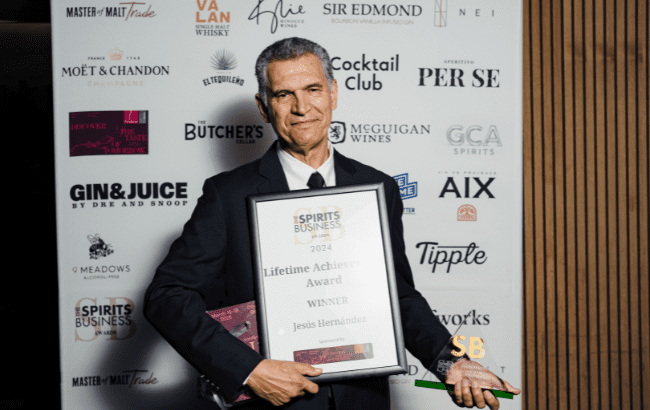
*This feature was originally published in the January 2025 issue of The Spirits Business magazine.
Mexico and the US have equally shaped Jesús Hernández into the man he is today. In agave circles, Hernández is extremely well known and respected – and for good reason.
The master distiller for Pernod Ricard’s House of Tequila arm has been instrumental in growing the 100% agave Tequila movement over the course of his career. Born in Mexico, Hernández moved to California in the US with his family when he was 11. His father worked as a bartender for many years, but this did not automatically carve a career in hospitality or drinks for Hernández, who took a more roundabout route into the trade. Before Hernández found his calling in Tequila, he was pursuing music and architecture.
“It was an interesting time in my life,” Hernández recalls. “My first son was one year old, and I was working as a musician at night and studying during the day. I was a bass player. I played in nightclubs six nights a week to finance college,” he explains about his time studying architecture, before gently being coaxed from his humble nature into admitting he is also a talented singer. “Music helped me finance my education, but I didn’t see that as a career plan,” he continues. “And with my son being born I had to think about the future and about his wellbeing.”
An illustrious career
A recommendation from a friend who worked at Seagram led Hernández to apply for a job there, marking the start of what would turn into an illustrious career spanning more than four decades. The facility in California was small, with “around 50 people” working there, Hernández recalls. “There were opportunities for learning. The management was very friendly, very receptive to getting new people on board. I guess they saw something in me. I was a quick learner, and interested in doing every aspect of the job that came along.”
Hernández remained there for 13 years, starting in the accounting department before moving into different operational areas. The last post was focused on quality assurance, with some PR for good measure. “It was a small facility, so we had to wear many hats. I was in just about every position in that facility, maintenance, planning, HR, quality – it was like a big school for me,” he says. After 13 years, the facility was shut down and the operation was transferred south to Carson in the Los Angeles area, Hernández explains. He moved too to Southern California, continuing to try his hand at any opportunity that presented itself – including practising his tasting skills with master blenders from Canada.
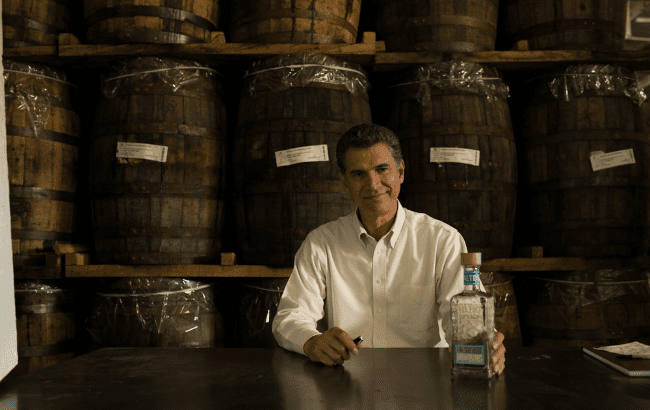
This was the early 1990s, when interest in Tequila had been steadily growing, Hernández says. Seagram started distributing Patrón Tequila in Carson. “We actually had issues with supply,” Hernández says about the demand for Tequila. “Every truckload that came into our distillery was allocated, every case was allocated, and that’s when the idea came up about building a distillery so we could have enough supply, and also bring in house a Tequila brand that Seagram had, which was Olmeca, created in the 1960s.”
In 1994, Hernández’s boss asked if he would like to take part in the project they had in mind for building a Tequila distillery in Mexico. “I was one of very few people in the operations of Seagram who spoke Spanish, and the only one that was from Mexico – and I was specifically from Jalisco. So I was a good fit.”
A team of engineers from Kentucky, and executives from New York were assembled, and Hernández was one of the leading minds on the project. He was hands-on from the start. “I made contact with one of my cousins in Guadalajara to ask him for a real estate agent to help us look for the site,” Hernández remembers. “That search was really interesting because we talked to a lot of people, agave growers, Tequila producers, and we were trying to find out where we wanted to locate the distillery.” Both the Tequila Valley and the Los Altos regions were contenders, but the latter location was eventually agreed upon.
“After a lot of interviews with people from the industry, what we heard was the agave from Los Altos had better sugar concentration, and could give us very good quality Tequila.” The local area was also very receptive to the move, Hernández adds.
More broadly speaking, Hernández has had a front-row seat during a momentous turning point for Tequila. The evolution from party slammer to premium product was starting. Hernández says: “Up until that time, Tequila was known for drinking fast and getting buzzed quickly. And, of course, a lot of people would talk about bad experiences with Tequila – and I have to declare that I was also one of those people that had that experience in the early years, so I could relate to that very well. It was the beginning of change from the industry to produce Tequilas that actually have flavour; up until that time, nobody really talked about the attributes of Tequila.”
The distillery, christened Destilería Colonial de Jalisco, had been designed to produce liquid that was destined to become Patrón. However, shortly after the distillery was completed in 1997, Patrón withdrew from its distribution with Seagram after a few months. It came shortly before Seagram continued its progression into the entertainment field, which resulted in the sale of its wine and spirits brands to Pernod Ricard and Diageo in 2001 – the Tequila portion went to Pernod Ricard.
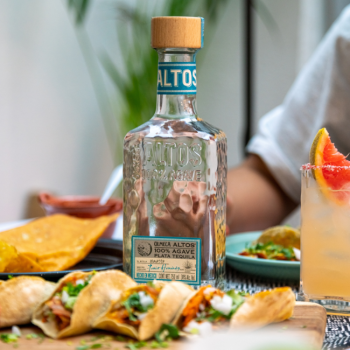
In hindsight, it proved to be beneficial for the Olmeca Tequila brand, which had been somewhat neglected under Seagram. Hernández and his team were committed to rebuilding the Olmeca brand. This ambition included reintroducing 100% agave Tequila to a global audience – which Hernández and his team achieved in 2004 with the launch of Olmeca Tezón, named after ‘tezontle’, the volcanic stone used to make tahona wheels used in Tequila production.
During a trip to Mexico four years later, Hernández would make another significant encounter. A meeting between Hernández and celebrated bartenders Dre Masso and Henry Besant led to the making of the now globally acclaimed 100% agave Tequila: Altos. “It gives me a lot of pride,” says Hernández when he reflects on the journey he took with Masso and Besant to create Altos. “We already had a lot of experience in developing different profiles because we had produced profiles for 100% of the Tequilas for the Mexican market for Pernod Ricard Mexico. When the idea came along to produce a Tequila for export markets like the UK and the US, the idea came to take advantage of the points of view of people that have very close contact with final consumers.” To put it another way – bartenders.
“Dre and Henry were passionate about Tequila, and passionate about Mexico in general, so it was, for me, a very joyous time to interact with people that had this intimate contact with consumers to hear their point of view. It was very valuable. Henry and Dre are very fine gentlemen, very easy to talk to and interact with,” Hernández says. Altos was nearly two years in the making, and is pitched as a Tequila made by bartenders for bartenders. Hernández supports that description. Commenting on how Altos is viewed today, Hernández notes: “A big reason for the success is that it has been well received by the bartender community around the world. It was because of their participation.”
Forefront of an evolution
When Altos came to market, it was still relatively unusual to create a 100% agave Tequila. But it was the fastest-growing category of Tequila at the time, Hernández says. What was it like to witness this evolution and to be at the forefront?
“It happened at different times in different markets. One of the first markets where it happened was the UK, and shortly after the US. Some markets are just starting to transition. As a whole industry, I saw the rapid growth of 100% agave Tequila starting there at the end of the ’90s, and catching up to the volume of ‘regular’ Tequilas around 2008/2009. And after that, 100% agave Tequila has surpassed the volumes of regular Tequila. It is a representation of what is happening around the world with the preference of consumers.”
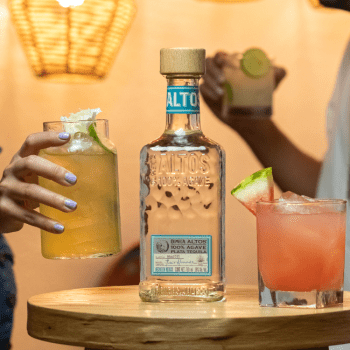
Hernández also credits the growing number of new distilleries, “especially in Los Altos”, for helping Tequila on its premiumisation path. “Their focus is producing artisanal Tequilas the old-fashioned way, not so much with tahonas, but with ovens and crushing the agave with a roller mill.” Once again, Hernández was ahead of the curve with a brand created in 2003, called Tezón. “It was 100% agave, 100% tahona, and it was just a bit ahead of our time there,” he admits. “Today, of course, consumers are very knowledgeable and would really appreciate a Tequila that is made the artisanal way using the tahona,” he adds.
The knowledge available today also means Tequila – along with other spirits categories – is more greatly scrutinised. Conversations lately have drawn attention to the use of additives in some products, and whether the category needs to become more transparent.
Hernández is thoughtful and measured in his response to this: “I don’t think Tequila is different from other spirits as far as transparency. The use of caramel, for example, is widely used by the spirits industry around the world as a visual effect for reducing variation in the bottles on the shelf. “In the case of Tequila, for the age classifications like reposado and añejo, the use of caramel along with three other ingredients – oak extract, sugar-based syrup, and glycerine – is not required to be declared on the label, even though they’re used.”
He continues: “Again, some of those ingredients are used in other spirits without declaring them on the label either, so Tequila is no different in that sense. Should that change, should producers be required to declare them on the labels? I think it would not hurt anybody. I think it would just help consumers make a more comfortable decision.
“Those ingredients, of course, have been tested for many, many decades without any significant effect to health. But if they’re creating some discomfort for consumers, we should reconsider to see whether they should be declared on the label.”
As master distiller, Hernández is heavily involved in continuing to push forwards the House of Tequila brands. Recent innovation from him includes a 2024 launch: Altos Infusionado, a pair of infused Tequilas that combine Altos Tequila with all-natural ingredients. Additionally, Hernández pioneered the first NFT expression for House of Tequila, Avión Lucky Liquid, a limited edition run of 100 bottles of extra añejo Tequila, aged for nine years in a single ex-wine oak cask.
Lifestyle achievement
These feats are just a handful of examples that propelled Hernández to success in The Spirits Business Awards 2024, where he was presented with the Lifetime Achievement Award. At the time, House of Tequila CEO Michael Merolli said: “None of these achievements would have been possible without the hard work that Jesús started by building our distillery in Jalisco all those years ago. Indeed, no-one should underestimate the massive contribution that Jesús has made, not only to the House of Tequila but to the category as a whole.” The judges echoed this sentiment, and wholeheartedly agreed Hernández richly deserved the accolade.
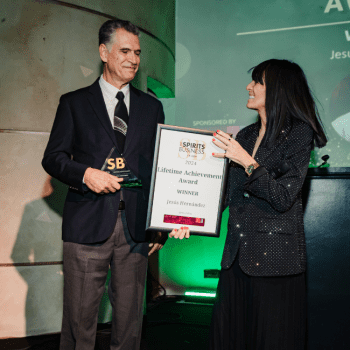
Ever humble, Hernández says: “I was very surprised that I was considered. It was totally unexpected. When the time came to go and be present [at the awards ceremony], I got very nervous. I was speechless. I’ve been very fortunate in getting people to believe in me. But I always have to say, the achievements that have been done, that we produce in our distillery are primarily because of the team we put together there that works every day to make it, so I represent them.”
Hernández has also passed his passion for Tequila to one of his sons, who is pursuing a career in the hospitality industry in Guadalajara, teaching people about Tequila. He will be the third Hernández generation to find their calling in the beverage world. “I hadn’t really thought about that,” Hernández says as he pauses to reflect.
“But yes, my son now, before me, my father was a bartender for so long, I think for close to 30 years. I’ve just enjoyed it all. I’m in the mode now of ‘less is more’, meaning working less and enjoying it more. So, I plan to just continue doing what I do now, to continue to enjoy the passion of Tequila, and to see it grow.”
Related news
World Spirits Report 2025: Tequila & mezcal
